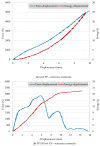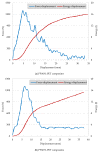The Multiple Uses of Polypropylene/Polyethylene Terephthalate Microfibrillar Composite Structures to Support Waste Management-Composite Processing and Properties
- PMID: 33921061
- PMCID: PMC8071395
- DOI: 10.3390/polym13081296
The Multiple Uses of Polypropylene/Polyethylene Terephthalate Microfibrillar Composite Structures to Support Waste Management-Composite Processing and Properties
Abstract
Composite processing and subsequent characterization of microfibrillar composites (MFC) were the focus of this work. Compression molding of wound MFC filaments was used to fabricate MFC composites. The MFC composites were composed of polypropylene (PP) as matrix materials and polyethylene terephthalate (PET) as reinforcement fibers. The PP/PET blends were mixed with PET contents ranging from 22 wt% to 45 wt%. The effect of processing parameters, pressure, temperature, and holding time on the mechanical properties of the MFCs was investigated. Tensile tests were conducted to optimize the processing parameter and weight ratio of PET. Tensile strength and modulus increased with the increase in PET content. PP/45 wt% PET MFC composites properties reached the value of PP/30 wt% GF. Falling weight tests were conducted on MFC composites. The MFC composites showed the ability to absorb the impact energy compared to neat PP and PP/30 wt% GF.
Keywords: PP/PET microfibrillar composites; automotive components; recycling; waste management.
Conflict of interest statement
The authors declare no conflict of interest.
Figures














References
-
- Directive 2000/53/EC of the European Parliament and of the Council. [(accessed on 7 January 2005)];2000 Available online: http://eurlex.europa.eu/LexUriServ/LexUriServ.do?uri=CONSLEG:2000L0053:2....
-
- Mazda Develops Automatic Bumper Recycling Process. [(accessed on 23 March 2009)];2009 Available online: http://green.autoblog.com/2009/03/23/mazdadevelops-automatic-bumper-recy....
-
- Mishra R.K., Verma K., Chaudhary R.G., Lambat T., Joseph K. An efficient fabrication of polypropylene hybrid nanocomposites using carbon nanotubes and PET fibrils. Mater. Today Proc. 2020;29:794–800. doi: 10.1016/j.matpr.2020.04.753. - DOI
-
- Narula C.K., Allison J.E., Bauer D.R., Gandhi H.S. Materials Chemistry Issues Related to Advanced Materials Applications in the Automotive Industry. Chem. Mater. 1996;8:984–1003. doi: 10.1021/cm950588m. - DOI
-
- Evstatiev M., Fakirov S. Microfibrillar Reinforcement of Polymer Blends. Polymer. 1992;33:877–880. doi: 10.1016/0032-3861(92)90354-Y. - DOI
LinkOut - more resources
Full Text Sources
Other Literature Sources
Miscellaneous

